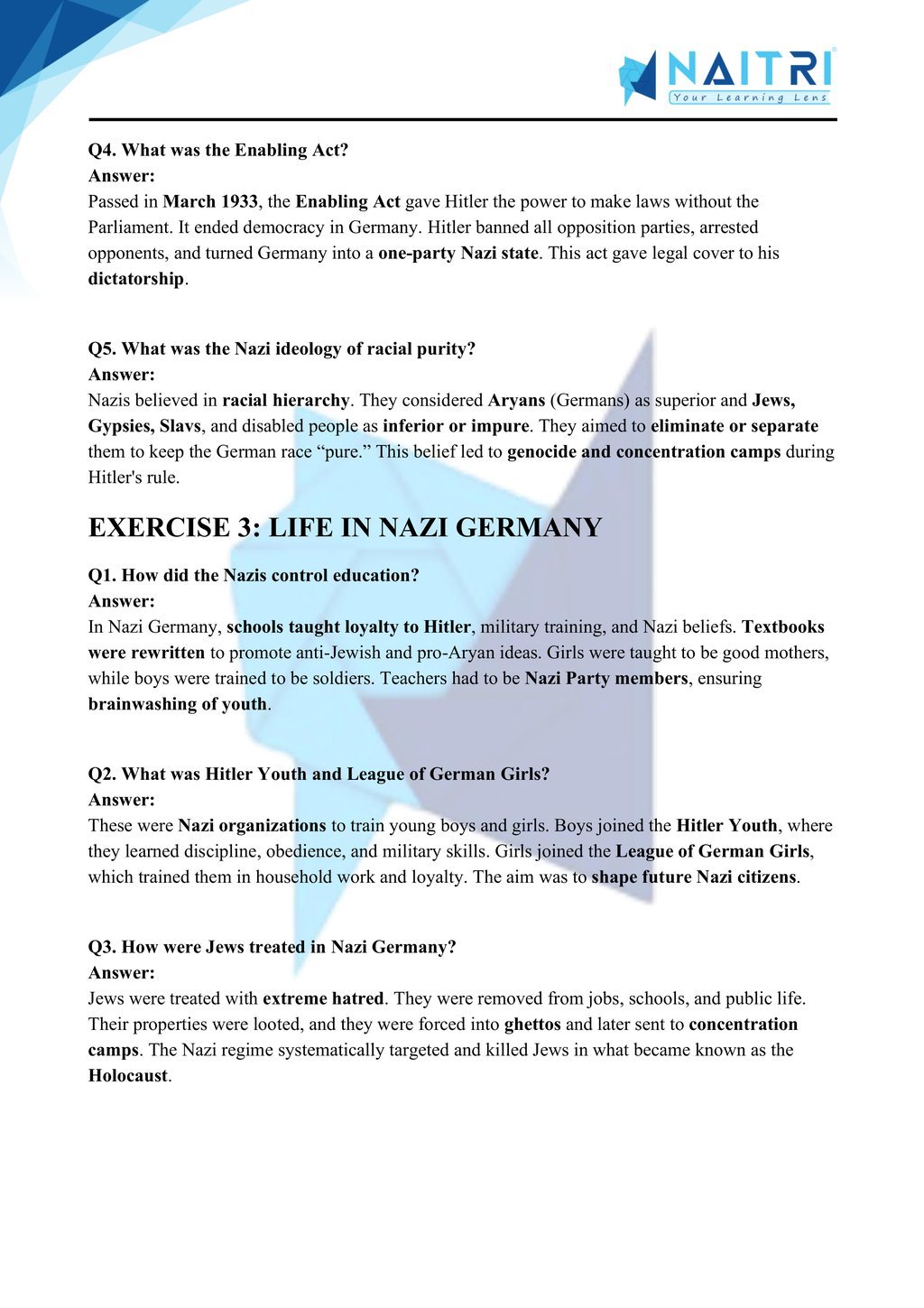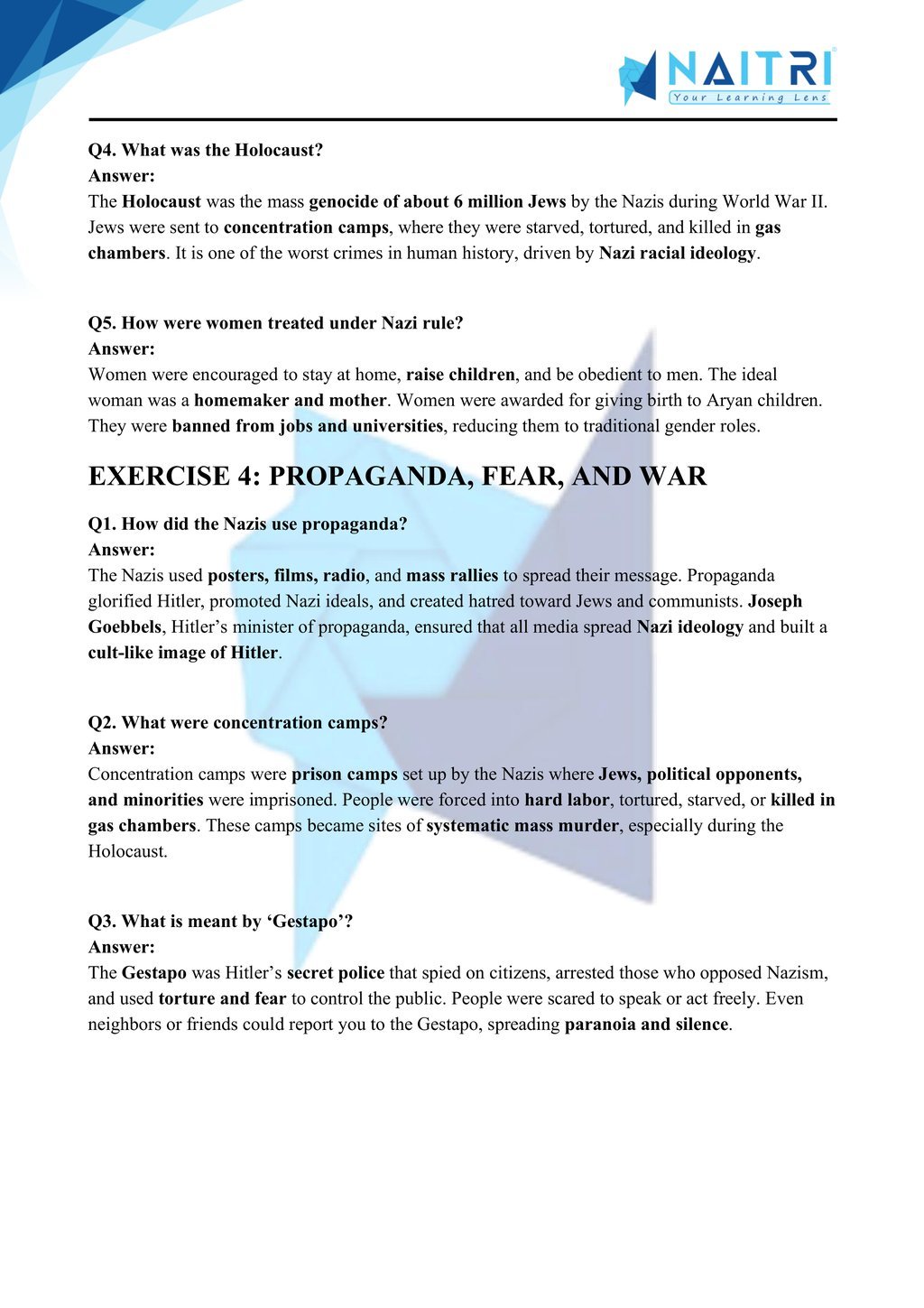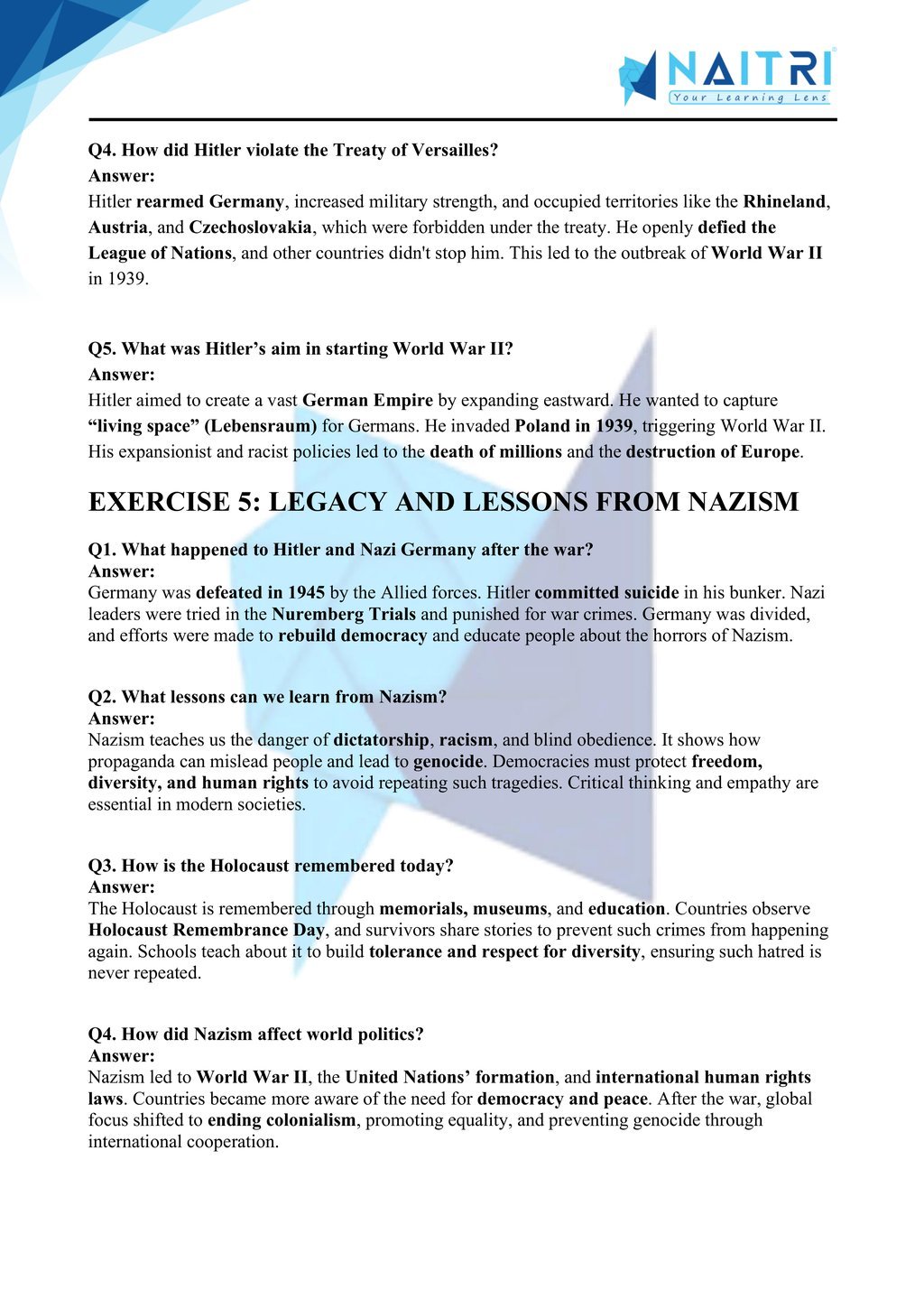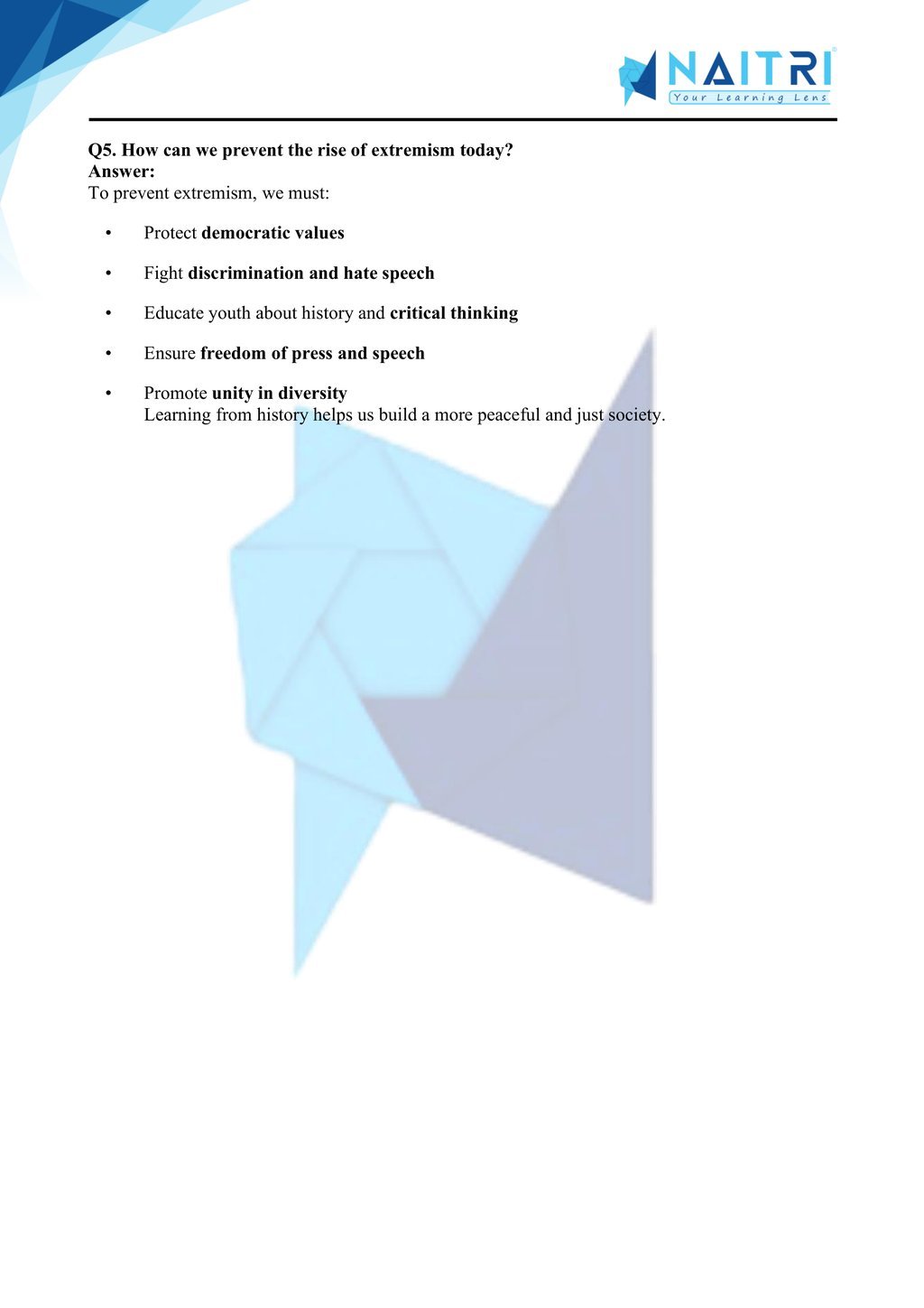MP Board Class 9 History Chapter 3 – Nazism and the Rise of Hitler
MP Board Solutions for Class 9 History Chapter 3 – Nazism and the Rise of Hitler are essential for understanding 20th-century world history in the MPBSE curriculum. These well-structured answers help students grasp topics like the impact of World War I, the Treaty of Versailles, rise of dictatorship, and Nazi ideology under Hitler. Designed as per the latest syllabus, these solutions strengthen conceptual clarity and improve exam preparation. Ideal for revision and practice, they encourage ethical reflection and historical reasoning, making them a valuable study tool for scoring well in Class 9 Social Science exams.
MP Board Solutions For Class 9 History – Nazism and the Rise of Hitler – Exercise Images






Experience History Like Never Before – With AR!
Understanding Nazism and the Rise of Hitler is now more exciting and immersive! With the NAITRI App, you can explore complex history concepts through Augmented Reality (AR). See propaganda spread, ideologies build, and global tensions rise — right in front of you. Our AR-powered lessons make learning interactive, 3D, and fun, helping you retain concepts better and enjoy every topic.



Visualize . Interact . Understand . The future of learning is here
Nazism and the Rise of Hitler – Important Questions with Answers
What was the Treaty of Versailles and how did it impact Germany?
Answer: The Treaty of Versailles imposed harsh penalties on Germany after World War I, including territorial loss, war guilt, and huge reparations, leading to economic crisis and public anger.Who was Adolf Hitler?
Answer: Adolf Hitler was the dictator of Germany, leader of the Nazi Party, who promoted Aryan supremacy, led Germany into World War II, and was responsible for the Holocaust.What is Nazism?
Answer: Nazism is an ideology based on extreme nationalism, racism, anti-Semitism, and militarism, aiming to establish Aryan dominance and destroy democracy and communism.How did Hitler rise to power in Germany?
Answer: Hitler used propaganda, economic crisis, fear of communism, and promises of national revival to win support, eventually becoming Chancellor in 1933 and establishing a dictatorship.What were the main features of Nazi ideology?
Answer: Nazi beliefs included racial purity, German nationalism, hatred of Jews, support for dictatorship, and the need for Lebensraum (living space) for Aryans.What was the Weimar Republic?
Answer: The Weimar Republic was Germany’s democratic government after World War I, which was weak, faced economic problems, and was blamed for signing the Treaty of Versailles.What was the Enabling Act?
Answer: The Enabling Act (1933) allowed Hitler to pass laws without parliament’s approval, giving him absolute power and effectively ending democracy in Germany.How did Hitler use propaganda to gain support?
Answer: Nazi propaganda used mass rallies, posters, radio, and films to glorify Hitler, spread anti-Jewish ideas, and create a strong leader image.What role did youth play in Nazi Germany?
Answer: German youth were trained through groups like Hitler Youth and League of German Girls to follow Nazi ideology, promote loyalty, and reject liberal ideas.How were women treated in Nazi Germany?
Answer: Women were expected to focus on motherhood, follow the policy of Kinder, Küche, Kirche (children, kitchen, church), and maintain racial purity through childbearing.What were the Nuremberg Laws?
Answer: The Nuremberg Laws (1935) denied Jews German citizenship, banned intermarriage, and created a legal basis for racial discrimination in Nazi Germany.What was the Holocaust?
Answer: The Holocaust was the genocide of over 6 million Jews and other minorities by the Nazis, carried out through concentration camps and mass executions.What is Aryan supremacy?
Answer: Aryan supremacy was the belief that Germanic people were racially superior, destined to rule over “inferior” races, especially Jews, Slavs, and Roma.How did Nazis control education?
Answer: Nazis used schools to spread militarism, obedience, and racism, rewriting textbooks to teach loyalty to Hitler and hatred toward Jews.What was Lebensraum?
Answer: Lebensraum means living space. Hitler aimed to expand eastward into Poland and Russia to provide land for German settlers and eliminate local populations.What was the role of the SS and Gestapo?
Answer: The SS and Gestapo were Nazi secret police that arrested, tortured, and killed opponents, spreading fearand ensuring obedience to Hitler.What was Kristallnacht?
Answer: Kristallnacht or “Night of Broken Glass” (1938) was a violent attack on Jewish businesses and synagogues, marking a major escalation in Nazi persecution.Why did Germans support Hitler?
Answer: Germans supported Hitler due to promises of jobs, stability, national pride, and because of propagandaand dissatisfaction with the Weimar Republic.What was the significance of the Nazi flag and symbol?
Answer: The swastika symbolized Aryan strength, and the Nazi flag represented the new German order, promoting unity and Hitler’s absolute authority.What were concentration camps?
Answer: Concentration camps were prison camps where Jews, political opponents, and others were sent for forced labor, torture, and often execution.What was Hitler’s foreign policy?
Answer: Hitler violated the Treaty of Versailles, built military power, and invaded Austria and Poland, starting World War II in 1939.How did World War II start?
Answer: World War II began when Germany invaded Poland in 1939, prompting Britain and France to declare war against Germany.What happened to Hitler at the end of the war?
Answer: As Germany lost the war, Hitler committed suicide in April 1945 in his Berlin bunker to avoid captureby the Allies.What were the effects of Nazi rule on Germany?
Answer: Nazi rule caused death, war, economic ruin, and long-lasting shame, including the loss of freedom, rights, and millions of lives.What lesson does Nazism teach the world?
Answer: Nazism teaches the dangers of dictatorship, racism, intolerance, and the importance of democracy, human rights, and peace in society.
Nazism and the Rise of Hitler examines the political, economic, and social conditions in Germany after World War I that led to the rise of Adolf Hitler and the Nazi Party. The chapter explores the ideology of Nazism, Hitler’s totalitarian regime, and the persecution of Jews and other minority groups. It highlights the dangers of dictatorship, propaganda, and racial discrimination, making students aware of the consequences of authoritarianism and fascism.
Download Naitri App
Easy, Visual Learning — Right on Your Phone
Learn with Augmented Reality! The Naitri app makes CBSE and MP Board concepts interactive and fun — even in low-resource settings. Watch lessons, complete homework, take tests, and track progress — all in one place. Anytime. Anywhere.
Available on








